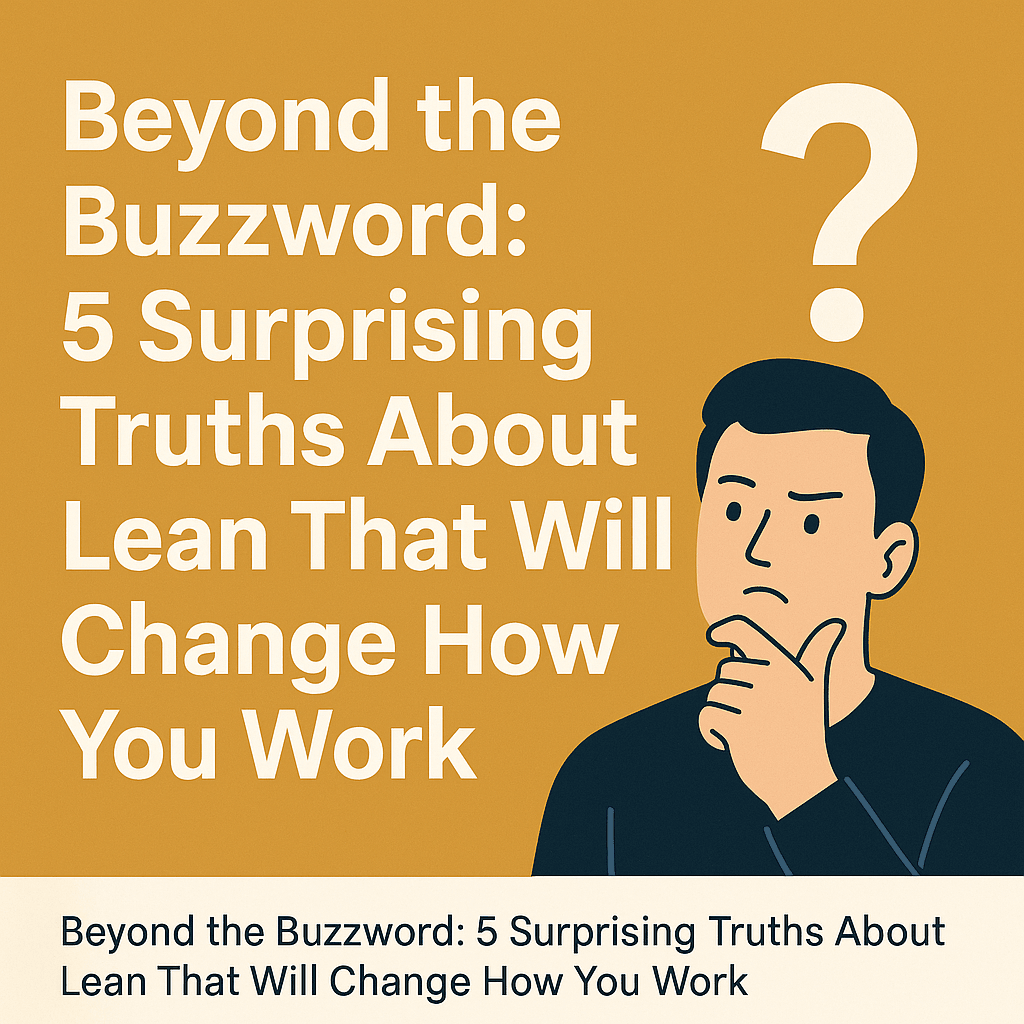5 Surprising Truths About Lean That Will Change How You Work

Ask a manager what "Lean" means, and you'll likely hear about cost-cutting, downsizing, or doing more with less. In the corporate lexicon, it's often a euphemism for being "mean"—a relentless, top-down push for efficiency. But this common perception misses the point entirely.
The core principles of Lean are surprisingly human-centric, strategic, and far more profound than this surface-level understanding suggests. Born from decades of practice at Toyota, true Lean is less about slashing budgets and more about building a culture of problem-solvers who relentlessly pursue a better way of delivering value. This article uncovers five of the most impactful and counter-intuitive truths about Lean management that will fundamentally change how you see your work, your team, and your entire organization.
It’s a Mindset, Not a Toolbox
Many organizations try to "do Lean" by adopting its most visible tools: Kanban boards appear on walls, teams are instructed to implement 5S checklists, and Six Sigma belts are handed out. But these efforts often fail because they treat Lean as a collection of standalone techniques rather than what it truly is: a management philosophy.
The term "Lean Production" was first coined in a 1988 article by John Krafcik, a researcher with MIT's International Motor Vehicle Program. After studying automotive plants around the world, he made a startling discovery. A plant's success was not best predicted by its level of automation or technology, but by its "management index"—a measure of factors like high levels of teamwork, low unscheduled absenteeism, a worker's span of control, and a low amount of space dedicated to repairs, which signaled a culture that built quality in from the start.
In other words, the culture and management system were the deciding factors. This reinforces a core Toyota principle: hitozukuri (developing people) is a precondition for monozukuri (making products). This focus on "developing people" is the foundation for everything that follows; it's what enables teams to see hidden waste, eliminate the root causes of customer friction, and use technology wisely. Without an underlying culture that respects people and empowers them to continuously improve their own work, the tools are just window dressing. A Kanban board doesn't solve problems; empowered people using the board as a tool do.
How might your team's approach to daily problems change if you saw your primary role as developing problem-solvers, not just managing tasks?
The Most Dangerous Waste Is Invisible Time
When most managers think of waste, they picture physical scrap, excess inventory, or redundant steps. Lean thinking broadens this definition, but its most radical insight is its focus on the most valuable and invisible resource of all: time. The legendary architect of the Toyota Production System, Taiichi Ohno, summarized the entire system this way:
“All we are doing is looking at the timeline, from the moment the customer gives us an order to the point when we collect the cash. And we are reducing the timeline by reducing the non-value adding wastes.”
The primary tool for this is Value Stream Mapping, where a team charts every single step a product or service takes on its journey to the customer. Managers often experience a profound shock when they do this for the first time. They discover that the actual value-added process time—the time spent physically working on the product—is a tiny fraction of the total lead time. A seemingly simple process, like approving a new marketing asset, might take 56 seconds of actual work but have a lead time of over five days.
The vast majority of that timeline is consumed by waiting: waiting for approvals, waiting in a queue, waiting for materials, waiting for information. This idle time is a form of waste that is invisible on any standard financial report, yet it has a massive impact on cost, capacity, and customer satisfaction. Lean reveals that your biggest opportunity for improvement isn't making people work faster, but eliminating the time they are forced to wait.
Map one simple, recurring process in your team. Where is the "invisible time," and what conversation could you start tomorrow to begin reducing it?
The Best Service Might Be No Service
What defines great customer service? Most companies would point to friendly call centers, rapid response times, and high "first-call resolution" rates. A Lean perspective offers a more provocative goal: what if the best customer service is eliminating the reasons a customer needs to contact you in the first place?
This idea, captured in the book title The Best Service is No Service, draws a critical distinction between work that creates value and work that restores value. When a customer calls to track a lost package, fix a billing error, or report a defective product, the service they receive isn't creating new value. It's simply restoring the value that was lost due to a failure somewhere upstream in the process.
A high volume of customer service interactions, therefore, isn't necessarily a sign of healthy customer engagement. It's often a symptom of a broken process. A Lean service organization uses every customer complaint not just as a problem to be solved, but as a signal to investigate and fix the root condition—the systemic circumstances, not just a single cause—that allowed the failure to happen. The ultimate goal isn't just to be good at putting out fires; it's to create processes so robust that fires never start.
How many of your team's daily tasks are spent "restoring value" for customers? What would happen if you dedicated that same energy to preventing the initial failure?
It’s Not Lean vs. Agile; It’s a Partnership
The debate over "Lean vs. Agile" has consumed countless hours in conference rooms, with leaders feeling they must choose one methodology over the other. This presents a false choice. The two systems are not competitors; they are partners built on a shared foundation.
Both Lean and Agile share the same foundational objectives: delivering value efficiently to a customer, discovering better ways of working through continuous improvement, and enabling people to contribute to their fullest potential. They simply provide different models and tools to achieve those goals in different contexts.
A thoughtful organization doesn't choose one; it blends them. Lean principles, with models like work cells, are exceptionally powerful for optimizing routine, repeatable operations where the goal is to create a stable, predictable, and efficient flow. Agile models, like cross-functional squads using Scrum, are ideal for creative, project-based work with variable demands, such as software development or new product innovation. The key is to stop arguing about which is "better" and start asking which model is right for the type of work being done.
Instead of debating which single methodology is "best," could you identify one repeatable process that would benefit from Lean's work cells and one creative project that needs an Agile squad?
Digital Isn’t the Solution; It’s a Spotlight
Companies often waste millions on digital transformation, investing in sophisticated new software and Industry 4.0 technologies without first asking the most fundamental question: "What problem am I trying to solve?" They buy the technology hoping it will be a magic solution, only to find they have merely automated a broken process.
In a Lean context, digital tools are most powerful when used not as a solution in themselves, but as a spotlight to make problems and waste visible in real time. Technology can bring issues that were once buried in the "hidden factory" to the surface, providing problem-solvers with the immediate, factual data they need to take swift and effective action. As one Lean coach famously put it:
"Information without action is MUDA [waste]."
The goal is not to have more dashboards; it's to enable faster and better problem-solving. Technology should serve the continuous improvement culture by arming teams with the insights they need to make smarter, data-driven decisions within the Lean framework.
Before your next technology request, can you frame the investment not as a solution, but as a spotlight designed to reveal a specific type of waste?
Conclusion: A More Human Way to Work
Stripped of its buzzword status, Lean reveals a more intelligent way to work. It begins with a mindset focused on developing people, which is the foundation for seeing and eliminating the invisible waste of time. This focus naturally extends to the customer, reframing service not as reactive firefighting but as the proactive elimination of process failures. This holistic view shows that methodologies like Lean and Agile are partners, not rivals, and clarifies that digital tools are merely spotlights to empower this human-centric system of continuous improvement.
As you look at your own organization, ask yourself a different kind of question. Instead of asking where you can cut costs, where can you start looking for invisible waste to unlock your team's true potential?


